Perception is reality. This classic line asserts the idea that however you perceive something is how it really is.
Reality is subjective and ultimately decided by the person experiencing it.
It’s a concept that can be applied to many facets of life. And fortunately for marketers, e-commerce is one of them.
A product’s intrinsic properties don’t really matter, nor does the cost to create it. What truly matters is the customer’s perceived value of the product.
If they believe it’s valuable, they’re more willing to buy it. If they don’t think it’s valuable, they’re likely to pass.
Perceived value is pound-for-pound one of the most important concepts for brands to understand because it affects two critical areas—pricing and conversions.
For this post, I’m going to discuss why perceived value is such a big factor in e-commerce and some actionable ways you can use it.

What Is Perceived Value?
Perceived value describes our tendency to evaluate the merits of a product or service and its ability to meet our needs and expectations when compared to other vendors.
8 Ways to Increase Your Perceived Value
7. Point Out That a Product is Worth More Than You’re Charging
A Classic Study on Perceived Value
Just over a decade ago, the Stanford Graduate School of Business and the California Institute of Technology performed an experiment involving wine taste testing.
A person was given two different types of wine. They were told that one costs $5 and the other costs $45.
But in reality, they were the exact same type of wine, only the pricing was different.
What happened?
People got more pleasure (as proven by brain scans) from drinking the $45 wine than they did from drinking the $5 wine and thought that it tasted better.
They perceived the $45 wine as being of higher quality than the $5 wine.
Head researcher Baba Shiv says, “The part of the brain that experiences pleasure will become more active when the drinker thinks he or she is enjoying the more expensive vintage.”
So in this regard, changing different factors (in this case pricing) can literally alter a person’s experience and actually affect real quality.
This goes to show just how big of an impact perceived value can have.
Capitalizing on this Phenomenon
This presents a tremendous opportunity for e-commerce brands.
Making some key adjustments means that you can increase perceived value without having to actually change anything about your product.
“Usually, customers are unaware of the factors involved in pricing a product or service, such as the actual or estimated costs of production,” Investopedia writes. “Customers rely on the emotional appeal of the product or service and their evaluation of the benefits they believe they will receive.”
Using the right techniques allows you to potentially charge more, while at the same time maximizing conversions.
Here are some of the best ways to do that.
1. Improve Design Aesthetics
The second someone lands on your e-commerce store, they form an impression of your brand.
Create a positive impression, and your perceived value will increase. Create a negative impression, and your perceived value will diminish.
And whether the impression is positive or negative largely boils down to design.
“A negative emotional reaction to some aspect of the design lowers the perceived value of the site and makes people abandon the site—often within a few seconds,” says Senior User Experience Specialist at Nielsen Norman Group, Aurora Harley. “On the other hand, if we like what we see and the page matches our expectations, we assign a high value for the website and its products or services.”
So improving design aesthetics is one of the most straightforward ways to increase perceived value.
But what exactly constitutes a “good” design?
For one, you’ll want it to be crisp, clean, and organized.
Dollar Shave Club does a great job at this with its product pages.
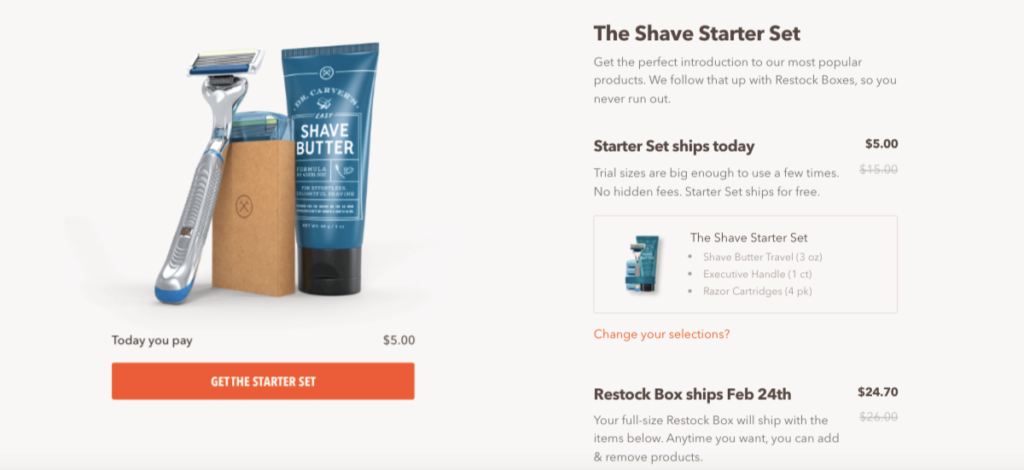
It has an uncluttered feel that naturally draws people in.
Professional, eye-catching images are another key component. You want the pictures to “pop” and stand out.
Superfood subscription box Daily Harvest is a company that uses beautiful product images with their healthy shakes.
Just look at this one for their Acai + Cherry smoothie.
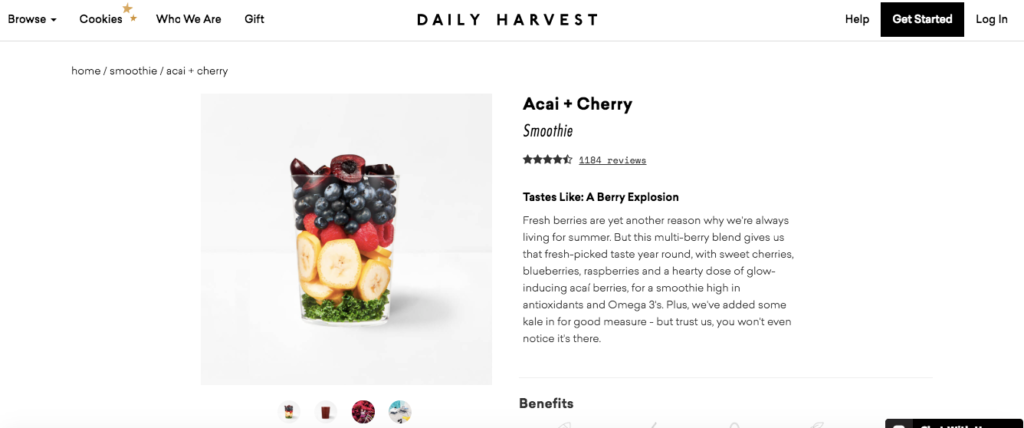
It uses a strong yet simple color palette, which looks amazing.
If your e-commerce store currently falls short of the mark, it’s usually worth the investment to redesign it so that it’s on the same level as these examples.
That right there can have a profound impact on perceived value.
2. Raise Product Price
As I mentioned with the wine tasting experiment example, pricing is one of the core elements of perceived value.
Generally speaking, people associate more expensive items as having more value.
And there’s a very simple reason for this.
“Markets in which people are not completely sure of how to assess quality, they use price as a stand-in for quality,” writes social psychologist Robert Cialdini.
I know that I do this all of the time on a subconscious level.
For instance, if I’m comparing two similar products from different brands, I tend to think that the higher priced product delivers more quality.
It’s just a natural reaction.
So I highly recommend experimenting with product pricing.
A study by MIT and the University of Chicago did this with a standard women’s clothing item. They offered the item at three different prices— $34, $39 and $44. What they found was that it sold the most at $39.
Twenty-one units were purchased at $39, while only 17 units were sold at $44 and 16 units were sold at $34.

So in this case, the cheapest price actually sold the least.
This is a simple example of how tinkering with pricing and charging a bit more can potentially increase conversions and revenue.
Of course, you need to be realistic about it.
You wouldn’t, for example, want to charge $30 for a roll of paper towels.
But there’s a good chance that you could raise your price slightly and make your product seem more desirable. The trick is to find the sweet spot and roll with that.
This brings me to my next point.
3. Use Charm Pricing
People are accustomed to seeing many products with prices ending in “99.”
Something costs $4.99 rather than $5, or it’s $9,999 rather than $10,000. It’s an old school technique known as charm pricing and is based on the psychological concept that people perceive “odd prices” as being lower than they actually are.
And there’s a sound body of evidence that suggests charm pricing is effective.
Online sales platform Gumroad experimented with this a few years ago and found that this technique had a significant impact on their conversions.
Here’s what I’m talking about.
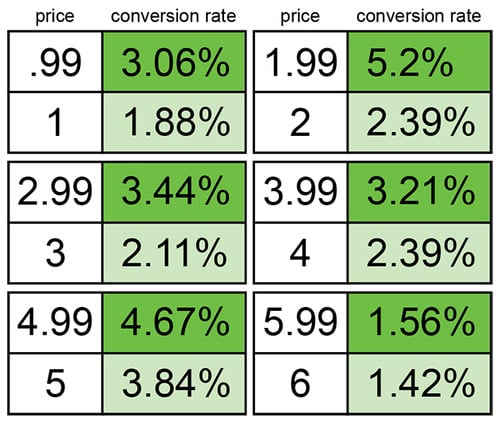
The conversion rate is noticeably higher across the board.
That’s why so many brands use it, like LifeStraw.
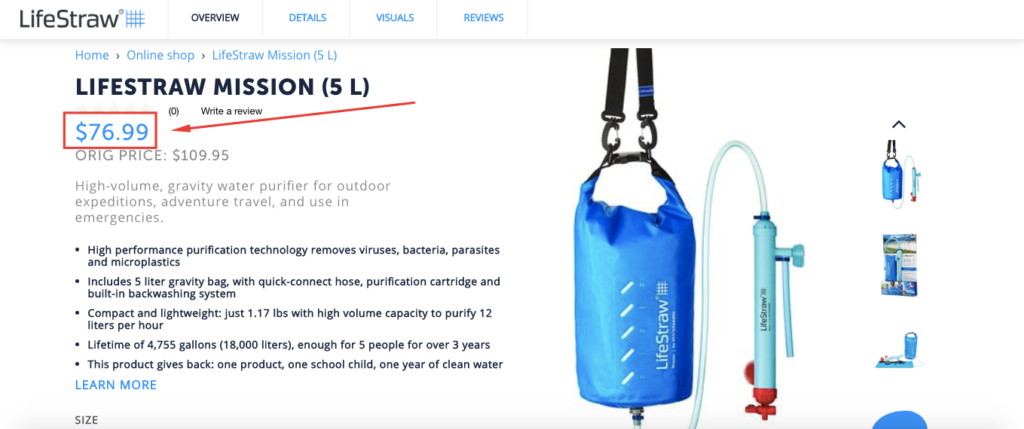
And the double hammock from Tanmit.
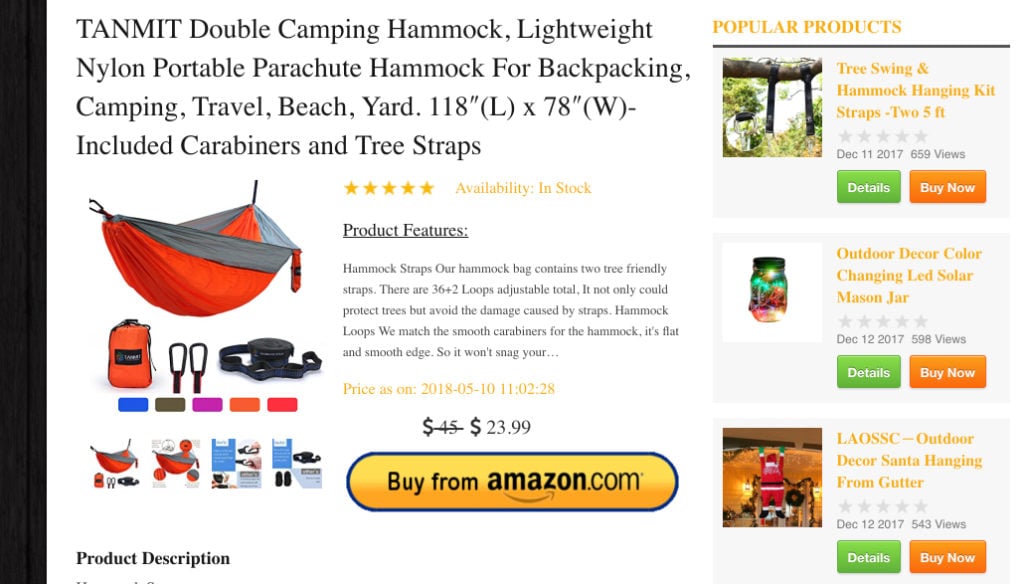
My point here is that using charm pricing in conjunction with increased pricing can take conversions to their highest possible level.
4. Emphasize Quality
At first glance, it may not always be obvious just how great a product really is. This is especially true when people are shopping online and can’t physically touch it.
Another big part of increasing perceived value is making quality a point of emphasis.
Does your product source high-end materials that go above and beyond what your competitors offer? Does it have a superior level of craftsmanship that can’t be found anywhere else?
Let your customers know about it. You don’t need to scream it from the rooftops, but casually working it into your copy should be helpful.
Take this landing page from minimalist wallet provider Infinity Wallet for example.
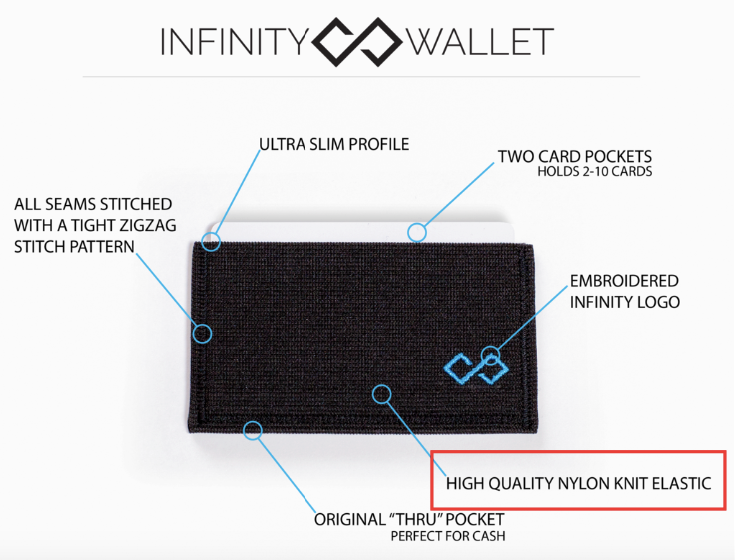
They succinctly highlight the unique features of their product and subtly point out that it uses high-quality nylon knit elastic.
Much like Bellroy, they also offer a side-by-side comparison of their wallet versus the average wallet so customers can get a feel for its size and how unique it is.
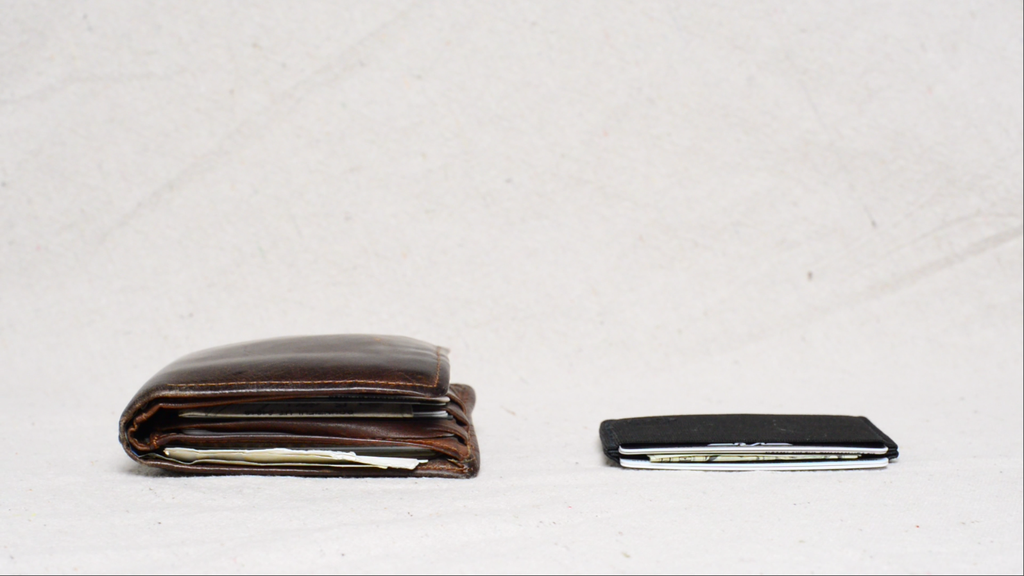
It doesn’t need to be anything over the top, but emphasizing quality and pointing out what makes your product special should raise its value level and motivate a higher percentage of people to purchase.
5. Convey Authenticity
Conversion optimization platform VWO performed an experiment to measure the impact of using authenticity as a selling point.
It was a simple A/B test involving men’s watch company Express Watches.
Many consumers were anxious about buying watches online out of fear that they would mistakenly buy imitation Seiko watches rather than originals.
So VWO changed one small detail on the landing page.
They switched a graphic from saying “Never Beaten on Price” to “Authorized Dealer Site” for Seiko watches in hopes of conveying authenticity.
Here’s what the original control version looked like.
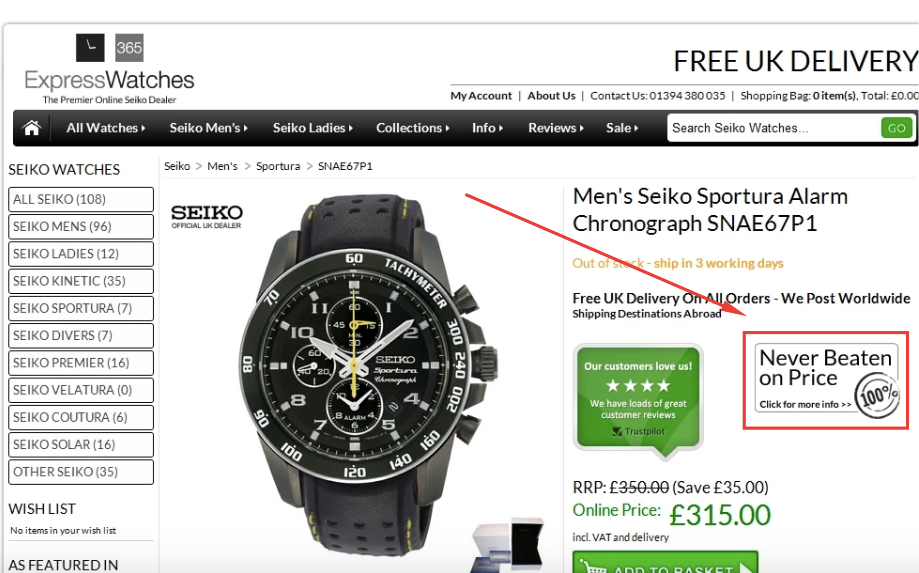
And here’s the modified version.
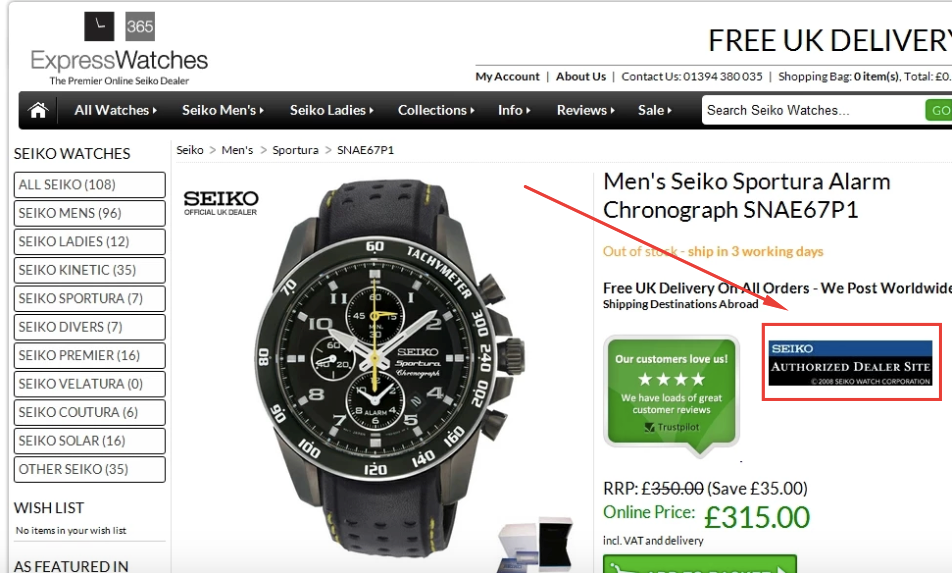
The changes are nothing dramatic, but adding a trust badge led to an amazing 107 percent spike in sales.
This shows that there’s definitely a link between demonstrating authenticity and increasing perceived value.
So this is something to consider when approaching your branding and copywriting.
6. Leverage Influencers
Having an industry influencer validate your brand can send your perceived value soaring. If someone your customers know and trust give it a thumbs up, it means it must be solid.
This doesn’t need to be a celebrity per se, it just needs to be someone easily identifiable by your audience.
That’s something SugarBearHair Vitamins does by joining forces with beauty and fashion blogger Anastasia Karanikolaou.

They had her feature one of their products on her Instagram account, which had 3.2 million followers as of early 2019.
Anastasia Karanikolaou isn’t a figure that the general public is familiar with, but a good chunk of beauty and fashion enthusiasts know about her.
And that’s what’s important.
You don’t need to shell out big money for celebrity endorsements. Often, it’s sufficient to reach out to industry influencers and have them vouch for your brand.
7. Point Out That a Product is Worth More Than You’re Charging
A $100 value for only $75. This is a type of deal that many shoppers are accustomed to seeing. It’s a technique that relies upon selling a product for less than the actual value. And it’s something that many people are receptive to. Customers may feel okay about buying a product for $75.
But knowing that it’s valued at $100 lets them know that they’re getting a great deal. You’re creating the perception that they’re getting more for their money, which is very appealing.
But here’s the thing: You need to be careful when using this technique. If you’re not careful, you can come off sounding like a sleazy infomercial. So be subtle about it.
8. Embrace Social Responsibility
VoucherCloud makes an interesting point that social responsibility equals value.
And I couldn’t agree more.
In our current climate, many consumers prefer to do business with brands that are socially responsible.
VoucherCloud even found that 50 percent of people aged 40-44 are willing to spend more on products from socially responsible companies.
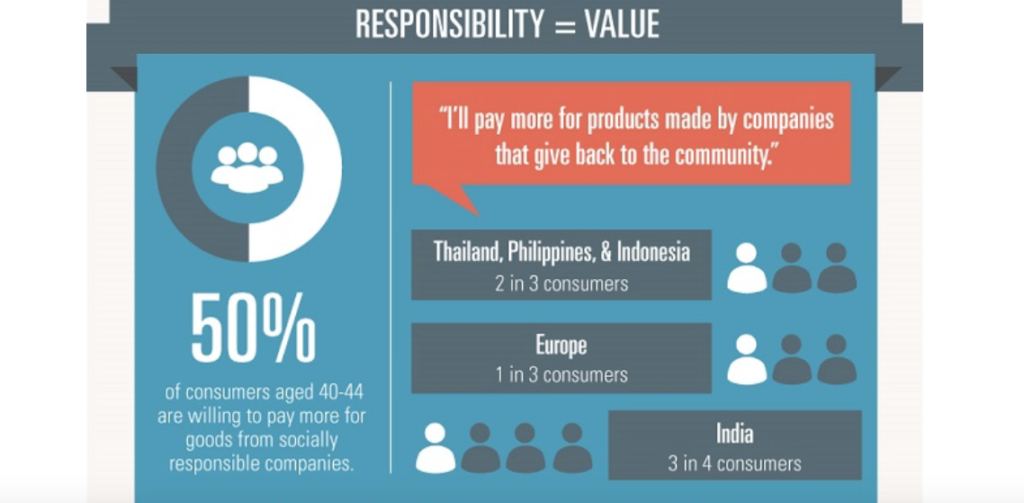
While this may not have been a huge deal 10 years ago, it’s a big deal now.
Social responsibility is a common trait that some of the world’s top companies share.
Just think of all the success ethical apparel provider TOMS has had. They’ve grown into a $400 million dollar empire, largely because of their “one for one” concept where they donate a product to someone in need for every purchase made.
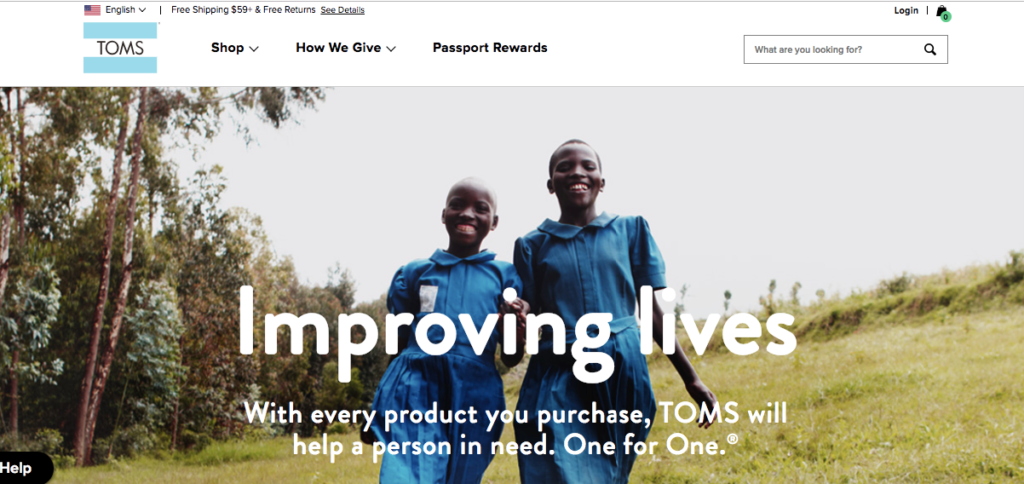
Most people love backing companies like this, and it increases perceived value.
While weaving social responsibility into a brand’s core business model and product line won’t be viable for all companies, it’s certainly an angle to be aware of and can work in some cases.

Conclusion
Gustave Flaubert once said, “There is no truth. There is only perception.” I think that’s a quote that sums up perceived value perfectly.
At the end of the day, good marketing is about conveying value to customers. Do that and you’ll be in a position to boost conversions and overall revenue. And as we’ve just learned, there are several ways to accomplish this.
Everything from web design optimization and adjusting pricing to being authentic and socially responsible can increase perceived value. It’s just a matter of finding the right combination and letting customers know that making a purchase is worth it.



